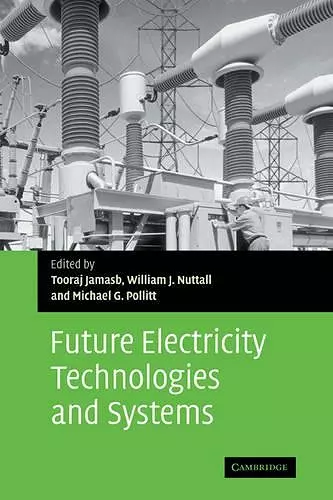Future Electricity Technologies and Systems
William J Nuttall editor Michael G Pollitt editor Tooraj Jamasb editor
Format:Hardback
Publisher:Cambridge University Press
Published:20th Jul '06
Currently unavailable, and unfortunately no date known when it will be back

An authoritative overview of the main technologies which could shape the future of electricity.
Where will our electricity come from in the future, and how will we use it? The UK is aiming for a 60% reduction of 1990 carbon dioxide emission levels by 2050, yet the electricity industry and patterns of electricity use must change radically if this is to be achieved. This authoritative overview analyses a range of possible scenarios for the future of electricity in the UK. Specialists in various renewable electricity technologies demonstrate the potential each has to play a significant role. Other routes to a low-carbon electricity system are also considered, including nuclear power, improved power electronics, a wider use of superconducting technology, and micro-generation systems including combined heat and power. The book concludes by examining opportunities for demand side improvements in architecture, industry and transport. Each chapter is written by a technical expert in a manner accessible to readers interested in energy technology, policy and economics.
'This is an invaluable source book for the energy technologies that will see us into the second half of the 21st century. Without increasing supplies of clean energy we will languish and stagnate. Only new technology can supply our insatiable demand for energy and fuel economic growth.' Ian Fells CBE FREng FRSE
'This book provides a series of well-informed and objective reviews of new and emerging technologies for supplying and using electricity in ways that would greatly reduce greenhouse gas emissions into the atmosphere. The range of options reviewed is wide, each of which is dealt with in a digestible and non-technical way: onshore and offshore wind; solar photovoltaics; bio-energy; wave energy; combined heat and power, both large and small scale; nuclear energy; new micro-generation technologies; carbon capture and storage from the use of fossil fuels; hydrogen production and use; small and large scale options for energy storage both to help shave peak demands and overcome the intermittency problem of some renewable energy sources; energy efficiency in buildings, transport and industry; and new developments in power electronics for the control and management of supply and demand. The picture is one of continual innovation and development arising from the efforts of engineers in many countries. It is to be hoped that the UK will substantially bolster its efforts on R&D and innovation, as the book clearly indicates is needed, since there is no reason why the UK-indeed why any country-could not meet its energy needs while addressing the climate change problem. The costs of the emerging options are higher than-but not far removed from-those of using fossil fuels and, with innovation, can be expected to decline.' Dennis Anderson, Imperial College London
'It's a pleasure to see a book on future electricity systems that foreswears the narrow advocacy of particular technologies and provides an authoritative account of all the options that may be needed in the coming decades. Renewables, nuclear and fossil all have their place in this book which not only deals with demand-side options but places individual technologies in a whole systems context. With energy now a key policy concern, this could become a standard reference for students and practitioners alike.' Jim Skea, Research Director, UK Energy Research Centre
ISBN: 9780521860499
Dimensions: 236mm x 159mm x 35mm
Weight: 860g
456 pages